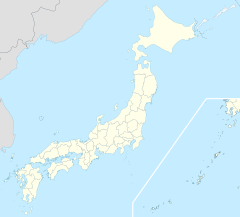railroad.wikisort.org - Station
Kamuro Station (学文路駅, Kamuro-eki) is a passenger railway station in the city of Hashimoto, Wakayama Prefecture, Japan, operated by the private railway company Nankai Electric Railway.
Kamuro Station 学文路駅 | |
|---|---|
 Kamuro Station building in April 2007 | |
| General information | |
| Location | 361-1, Kamuro, Hashimoto-shi, Wakayama-ken 648-0043 Japan |
| Coordinates | 34°17′47.9″N 135°34′49.3″E |
| Operated by | |
| Line(s) | |
| Distance | 50.4 km (31.3 mi) from Shiomibashi |
| Platforms | 2 side platforms |
| Other information | |
| Status | Unstaffed |
| Station code | NK79 |
| Website | Official website |
| History | |
| Opened | 1 November 1924 |
| Passengers | |
| FY2019 | 436 daily |
| Location | |
 Kamuro Station Location within Wakayama Prefecture  Kamuro Station Kamuro Station (Japan) | |
Lines
Kamuro Station is served by the Nankai Kōya Line, and is located 50.4 kilometers from the terminus of the line at Shiomibashi Station and 49.7 kilometers from Namba Station.
Station layout
The station consists of two opposed side platforms connected to the station building by a level crossing. The station is unattended.
Platforms
| 1 | ■ Nankai Kōya Line | for Kōyasan |
| 2 | ■ Nankai Kōya Line | for Nanba |
Adjacent stations
| « | Service | » | ||
|---|---|---|---|---|
| Koya Line | ||||
| Limited Express "Koya": Does not stop at this station | ||||
| Hahsimoto | Sightseeing train "Tenkū" | Kudoyama | ||
| Kii-Shimizu | Rapid Express | Kudoyama | ||
| Kii-Shimizu | Express | Kudoyama | ||
| Kii-Shimizu | Local | Kudoyama | ||
History
Kamuro Station opened on November 1, 1924. The Nankai Railway was merged into the Kintetsu group in 1944 by orders of the Japanese government, and reemerged as the Nankai Railway Company in 1947.
Passenger statistics
In fiscal 2019, the station was used by an average of 436 passengers daily (boarding passengers only).[1]
Surrounding area
- Kamuro Tenmangu
- Kamuro Daishi
- Hashimoto City Kamuro Elementary School
See also
- List of railway stations in Japan
References
- 和歌山県統計年鑑(令和2年度刊行) [Wakayama Prefectural Statistical Yearbook] (in Japanese). Japan: Wakayama Prefecture. 2020. Retrieved 11 August 2021.
External links
![]() Media related to Kamuro Station at Wikimedia Commons
Media related to Kamuro Station at Wikimedia Commons
Другой контент может иметь иную лицензию. Перед использованием материалов сайта WikiSort.org внимательно изучите правила лицензирования конкретных элементов наполнения сайта.
WikiSort.org - проект по пересортировке и дополнению контента Википедии